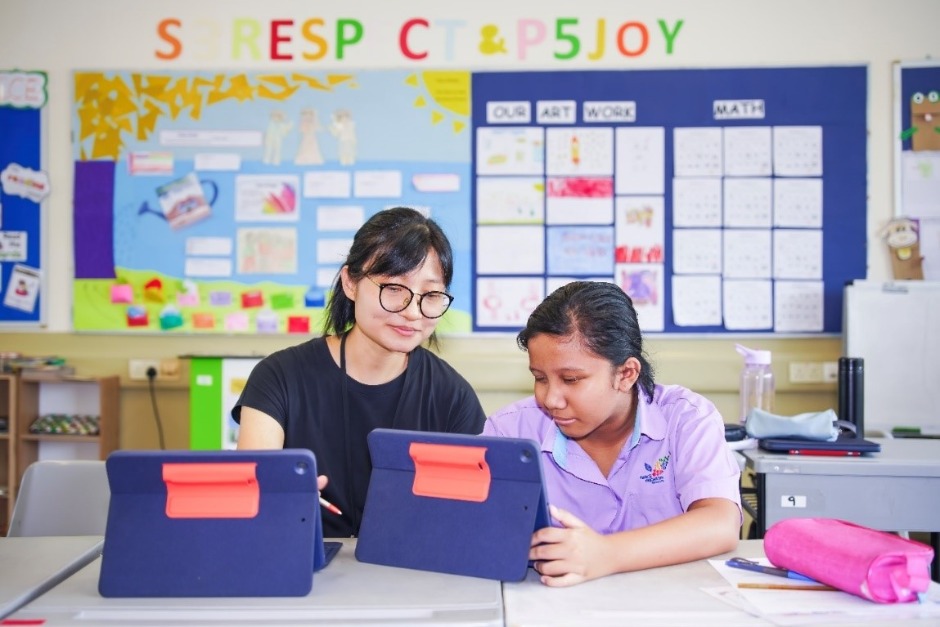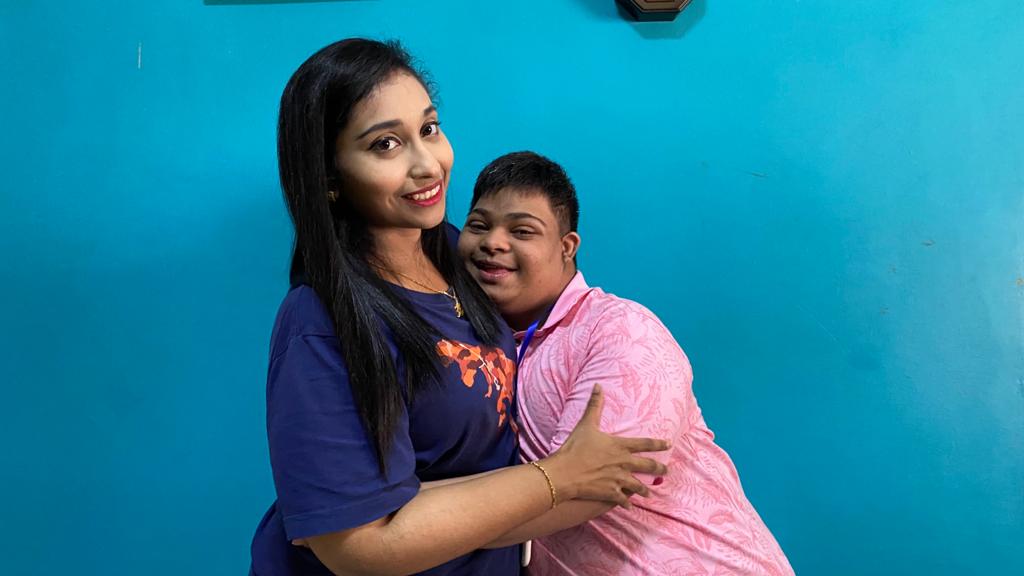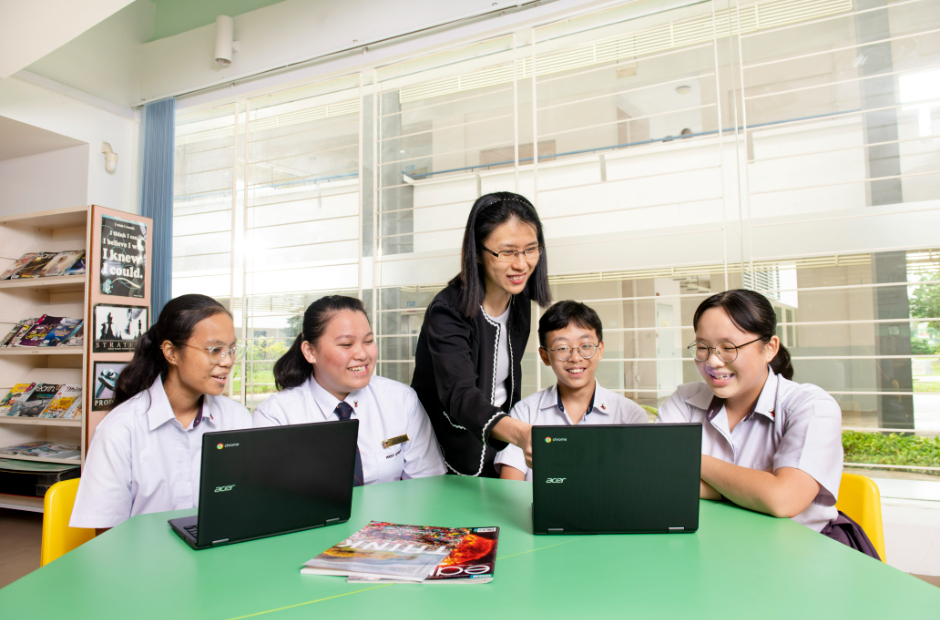‘I work in more ways to improve the verbal skills of those with hearing loss’
Mr Hue Tan, Teacher, Canossian School

I had taught Mathematics and Physical Education in mainstream schools for approximately 20 years. In 2017, I was assigned to teach Hon Wei, a student with hearing loss, when he was in Primary 6.
I found myself exploring new ways to better connect with him, support him in class, and above all, build his confidence to have his voice heard by others. That humbling experience with Hon Wei made me realise I had so much more to learn about and contribute to the community of students with sensory needs.
When the chance for secondment to Canossian School – a Special Education (SPED) school dedicated to students with hearing loss – came up in 2021, I wanted to go for it. Since then, as I navigated new terrain in a SPED school, the support, guidance and encouragement extended by my colleagues have opened my eyes to new ways of teaching.
As speech is a major challenge for the hearing-impaired, I now prioritise my students’ oral communication skills alongside their understanding of a topic when planning and conducting my lessons.
For example, I would encourage all my students to take part in class discussions, and I’d acknowledge every one of their contributions, to make it a safe space for them to make mistakes when speaking.
Students are also offered sentence starters – a word or phrase at the beginning of a sentence – to encourage them to complete the sentences themselves; their confidence in expressing themselves is boosted greatly this way.
What a sight it has been to see their slow but steady willingness to speak up more in class. I’m planning for some show-and-tell opportunities next, to take their verbal skills further.
Looking back, my efforts to support Hon Wei in his learning were limited to assigning him to seats at the front of the class, and speaking more slowly and loudly during lessons. The experiences at Canossian School have made me more prepared to support students like Hon Wei when I return to mainstream teaching.
‘I teach independence through visual tools for my students with autism’
Ms Lydia Pei Hua Wang, Teacher, St Andrew’s Mission School
In 2020, I enrolled in the Master of Education (Special Needs) programme, which gave me a better understanding of the challenges that students with special education needs face, and effective strategies to support them.
What spurred me to pursue the programme was my experience with two ex-students at Kuo Chuan Presbyterian Primary School, who were diagnosed with autism. My experiences in supporting them left me feeling helpless at times. I was thankful that the Special Education Needs (SEN) officer provided some tips to help my students.
Through this, I gained an important realisation – no two students with the same diagnosis are the same. This fuelled my desire to equip myself with a likewise diverse range of support strategies.
In 2022, I started teaching at St Andrew’s Mission School (SAMS), which caters to children and youths on the autism spectrum who access the national curriculum at the primary and secondary levels.
Being the strong visual learners they are, I saw how powerful visual support tools are in strengthening my students’ capability of organising themselves. For example, a checklist can help them tick off tasks that they need to complete. This reduces the need for adult prompting and encourages students to be more independent when carrying out tasks. Being able to structure their tasks is especially important and helpful for my students with executive functioning challenges. I saw how these tools enabled my students to stay on track and transit better between tasks.
With more support strategies under my belt, I can deploy more appropriate ones for the challenges at hand; I can see that my students are better engaged and are flourishing in their own ways.
At the heart of my journey is the belief that every child can learn and achieve what they set out to do. Indeed, my students in SPED school surprise me with what they can actually accomplish with the right support strategies provided for them. I look forward to continuing this meaningful work and making a difference in their lives.
‘I have more teaching approaches for different learning styles’
Ms Sua Kerbie, Teacher, Grace Orchard School
After teaching in mainstream schools for over a decade and providing support to some students with autism, I wanted to learn more about supporting students with higher learning needs.
So, in June 2021, I applied for secondment to Grace Orchard School, which serves students aged seven to 18 with mild intellectual disability and/or Autism Spectrum Disorder, and joined the school in June 2022.I’ve been observing their learning styles during our daily interactions and adapted my teaching approaches to meet their needs.For instance, when I noticed my students struggling with mental calculations, I introduced digital games and simple board games. My students multiplied dice numbers to complete a row in Bingo, and added the dice numbers for Snakes and Ladders. This helped them improve their speed and accuracy in solving arithmetic problems and most importantly, made learning joyful.
Apart from these tools, I also realised the importance of providing clear step-by-step instructions with visuals when helping my students grasp more complex Maths concepts.
I’ve learnt that pacing my lessons and providing clear, detailed explanations and instructions help my students understand and learn better. These are all transferable skills that I will take along with me when I return to support students in mainstream schools.
I’m also motivated to help my students pick up skills that will broaden their future opportunities. For instance, Putri Nur Salihah (pictured above), was very good at designing comic characters. We explored ways to improve her characters’ costumes and facial expressions, so she could pursue this career aspiration.
Seeing tears of joy at every parent-teacher engagement session makes the hard work worth it. I take heart that every ounce of effort counts and has a positive impact on our students and their parents, even if the fruits of our labour aren’t always immediately obvious.
‘I customise various tools to foster positive behaviour’
Ms Zhang Wanqi, Head of Department, Social-Emotional Learning/Character Citizenship Education, Tanglin School
I served as a Year Head and Special Education Needs (SEN) Champion at Alexandra Primary School (ALPS) before joining Tanglin School in June 2022.
As a SEN Champion in ALPS, I was afforded many opportunities to empower and advocate for students with SEN. Embracing this role eventually led me to join a SPED school, where I knew I wanted to make a difference to the lives of students with SEN.
Tanglin School serves students aged 13 to 16 with mild intellectual disability and/or Autism Spectrum Disorder (ASD). When I joined, I was so excited to learn from my colleagues’ good practices. Slightly more than a year since then, I still enjoy observing and learning from experienced teachers and allied professionals from how they speak to students to how they develop a plethora of purposeful tools to shape and influence students’ behaviours.
One useful technique that I have learnt to encourage positive behaviour is the use of visuals. Most visual tools used in Tanglin School state explicitly the desired behaviours, the reward for complying and the consequence for behaving otherwise. These visuals are individualised and usually made easy enough for students to use, to encourage them to take ownership in tracking their own behaviours. For example, each time my students exhibit a positive behaviour, they may use their whiteboard markers to reflect that on their own visual with a tick. At the end of the day, students will be able to self-assess how well they have fared in behaving appropriately and strive to do better.
I am proud to see how some students have internalised the positive behaviours over time, because deep down I know that they have earned themselves skills which are integral in life.
Speaking of preparing our SPED students for life, I am grateful to have a team of passionate colleagues who work alongside me in developing and fine-tuning Social-Emotional Learning teaching resources. Together, we ensure that these resources are tailored to meet the needs of our students. Nothing beats having a team who shares the common goal of wanting these young persons to be equipped adequately with social-emotional skills critical for their success in school, the community and in life.
The adage “different strokes for different folks” resonates deeply with me. My time in Tanglin School has allowed me to use different tools and approaches to meet the diverse learning needs of students.










